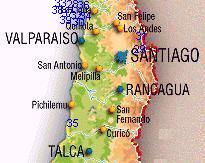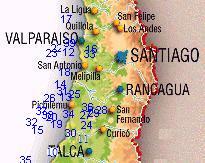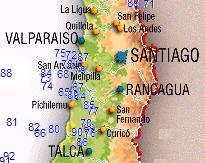Un "Desastre Natural" es simplemente un fenómeno físico que nadie se preocupó de predecir
| Septiembre de 2024 | x |
|
| |||
|
TERREMOTOS * Libro 1: Terremotos * Libro 2:
Predicción Científica de Sismos |
|
5. Red de Alerta Sísmica Libro 3: Cómo
Sobrevivir a Terremotos y Tsunamis Libro
4: Resumen de Papers e Informes |
|
Sismos ocurridos en Chile entre las latitudes
32.5ºS y 35ºS, aproximadamente:
|
||||||||||||||||||||||||||||||||||||||||||||||||||||||||||||||||||||||||||||||||||||||||||||||||||||||||||||||||||||||||||||||||||||||||||||||||||||||||||||||||||||||||||||||||||||||||||||||||||||||||||||||||||||||||||||||||||||||||||||||||||||||||||||||||||||||||||||||||||||||||||||||||||||||||||||||
|
Año
2004: 1-20: 2004 y
2005: 21-40 |
|
|
||||||||||||||||||||||||||||||||||||||||||||||||||||||||||||||||||||||||||||||||||||||||||||||||||||||||||||||||||||||||||||||||||||||||||||||||||||||||||||||||||||||||||||||||||||||||||||||||||||||||||||||||||||||||||||||||||||||||||||||||||||||||||||||||||||||||||||||||||||||||||||||||||||||||||||
|
2005: 41- 59 2005: 60- 74 |
.. |
.. |
||||||||||||||||||||||||||||||||||||||||||||||||||||||||||||||||||||||||||||||||||||||||||||||||||||||||||||||||||||||||||||||||||||||||||||||||||||||||||||||||||||||||||||||||||||||||||||||||||||||||||||||||||||||||||||||||||||||||||||||||||||||||||||||||||||||||||||||||||||||||||||||||||||||||||||
|
2006: 75-93 2006: 94-14 2006 y 2007: 15-34 |
|
|
||||||||||||||||||||||||||||||||||||||||||||||||||||||||||||||||||||||||||||||||||||||||||||||||||||||||||||||||||||||||||||||||||||||||||||||||||||||||||||||||||||||||||||||||||||||||||||||||||||||||||||||||||||||||||||||||||||||||||||||||||||||||||||||||||||||||||||||||||||||||||||||||||||||||||||
|
Año 2007: 35-54 |
2006-07
|
2007
|
||||||||||||||||||||||||||||||||||||||||||||||||||||||||||||||||||||||||||||||||||||||||||||||||||||||||||||||||||||||||||||||||||||||||||||||||||||||||||||||||||||||||||||||||||||||||||||||||||||||||||||||||||||||||||||||||||||||||||||||||||||||||||||||||||||||||||||||||||||||||||||||||||||||||||||
|
Año 2008: 61 - 69 Año 2008: 70 - 83 Año 2008: 84 - 05
|
|
|
||||||||||||||||||||||||||||||||||||||||||||||||||||||||||||||||||||||||||||||||||||||||||||||||||||||||||||||||||||||||||||||||||||||||||||||||||||||||||||||||||||||||||||||||||||||||||||||||||||||||||||||||||||||||||||||||||||||||||||||||||||||||||||||||||||||||||||||||||||||||||||||||||||||||||||
|
|
|
|||||||||||||||||||||||||||||||||||||||||||||||||||||||||||||||||||||||||||||||||||||||||||||||||||||||||||||||||||||||||||||||||||||||||||||||||||||||||||||||||||||||||||||||||||||||||||||||||||||||||||||||||||||||||||||||||||||||||||||||||||||||||||||||||||||||||||||||||||||||||||||||||||||||||||||
|
Año 2010: 84-09
Año 2010: 10-39 |
|
|
||||||||||||||||||||||||||||||||||||||||||||||||||||||||||||||||||||||||||||||||||||||||||||||||||||||||||||||||||||||||||||||||||||||||||||||||||||||||||||||||||||||||||||||||||||||||||||||||||||||||||||||||||||||||||||||||||||||||||||||||||||||||||||||||||||||||||||||||||||||||||||||||||||||||||||
|
64-80
81-09
10-40
|
|
|
||||||||||||||||||||||||||||||||||||||||||||||||||||||||||||||||||||||||||||||||||||||||||||||||||||||||||||||||||||||||||||||||||||||||||||||||||||||||||||||||||||||||||||||||||||||||||||||||||||||||||||||||||||||||||||||||||||||||||||||||||||||||||||||||||||||||||||||||||||||||||||||||||||||||||||
|
93-08 |
|
|
||||||||||||||||||||||||||||||||||||||||||||||||||||||||||||||||||||||||||||||||||||||||||||||||||||||||||||||||||||||||||||||||||||||||||||||||||||||||||||||||||||||||||||||||||||||||||||||||||||||||||||||||||||||||||||||||||||||||||||||||||||||||||||||||||||||||||||||||||||||||||||||||||||||||||||
26-46
2011: 47-64 |
|
|
||||||||||||||||||||||||||||||||||||||||||||||||||||||||||||||||||||||||||||||||||||||||||||||||||||||||||||||||||||||||||||||||||||||||||||||||||||||||||||||||||||||||||||||||||||||||||||||||||||||||||||||||||||||||||||||||||||||||||||||||||||||||||||||||||||||||||||||||||||||||||||||||||||||||||||
2012: 95 - 12 2012-2013: 13-38 |
|
|
||||||||||||||||||||||||||||||||||||||||||||||||||||||||||||||||||||||||||||||||||||||||||||||||||||||||||||||||||||||||||||||||||||||||||||||||||||||||||||||||||||||||||||||||||||||||||||||||||||||||||||||||||||||||||||||||||||||||||||||||||||||||||||||||||||||||||||||||||||||||||||||||||||||||||||
2013: 39-63
|
|
| ||||||||||||||||||||||||||||||||||||||||||||||||||||||||||||||||||||||||||||||||||||||||||||||||||||||||||||||||||||||||||||||||||||||||||||||||||||||||||||||||||||||||||||||||||||||||||||||||||||||||||||||||||||||||||||||||||||||||||||||||||||||||||||||||||||||||||||||||||||||||||||||||||||||||||||
|
2014:
91-13 (2015)
2015:
14-50 2016: 51-81
|
|
|
||||||||||||||||||||||||||||||||||||||||||||||||||||||||||||||||||||||||||||||||||||||||||||||||||||||||||||||||||||||||||||||||||||||||||||||||||||||||||||||||||||||||||||||||||||||||||||||||||||||||||||||||||||||||||||||||||||||||||||||||||||||||||||||||||||||||||||||||||||||||||||||||||||||||||||
2017: 82-29 2017: 30- 47 (2018)
2018:
48-61
2018 - 2019: 62- 68 |
|
|
||||||||||||||||||||||||||||||||||||||||||||||||||||||||||||||||||||||||||||||||||||||||||||||||||||||||||||||||||||||||||||||||||||||||||||||||||||||||||||||||||||||||||||||||||||||||||||||||||||||||||||||||||||||||||||||||||||||||||||||||||||||||||||||||||||||||||||||||||||||||||||||||||||||||||||
2019-2021: 71-99
2021: 00-05; 2022: 06-10
|
Marzo-Diciembre de 2020
|
Abril 2021 - 2024
|
||||||||||||||||||||||||||||||||||||||||||||||||||||||||||||||||||||||||||||||||||||||||||||||||||||||||||||||||||||||||||||||||||||||||||||||||||||||||||||||||||||||||||||||||||||||||||||||||||||||||||||||||||||||||||||||||||||||||||||||||||||||||||||||||||||||||||||||||||||||||||||||||||||||||||||
2024: 22- |
|
|||||||||||||||||||||||||||||||||||||||||||||||||||||||||||||||||||||||||||||||||||||||||||||||||||||||||||||||||||||||||||||||||||||||||||||||||||||||||||||||||||||||||||||||||||||||||||||||||||||||||||||||||||||||||||||||||||||||||||||||||||||||||||||||||||||||||||||||||||||||||||||||||||||||||||||
Artículos
sobre predicción (CIENTÍFICA) de sismos
1. California Earthquake Prediction Evaluation
Counsel (1977), Earthquake Prediction Evaluation Guidelines. California
Office of Emergency Services.
2. Rikitake, T. (1976), Earthquake prediction.
Elsevier Scientif. Publish. Co., Países Bajos.
3. Mogi, K. (1985),
Earthquake prediction. Academic Press Inc.,
EUA.
4. Davies, G., y J. Brune (1971), "Regional and global fault
slip rates from seismicity". Nature Phys. Science., vol. 229, pp. 101-107.
5. McNally, K. (1981), "Plate subduction and prediction
of earthquakes along the Middle America Trench", en Earthquake Prediction,
Maurice Ewing Series 4, Am. Geophys. Union, EUA, pp. 63-72.
6. Núñez,
F. (1980), Sismicidad (M = 3) en la región del temblor de Oaxaca (29
de noviembre de 1978, Ms = 7.8); observaciones del 20 de enero al 15 de abril
de 1979. Tesis profesional, Fac. Ciencias, UNAM.
7. Wallace, R., J. Davis
y K. McNally (1984), "Terms for expressing earthquake potential, prediction
and probability". Bull. Seism. Soc. Amer., vol. 26, pp. 1819-1825.
8. Vere-Jones, D. (1978), "Earthquake prediction
- a statistician's view". J. Phys. Earth, vol. 26, pp. 129-146.
9. Lomnitz, C., y L. Lomnitz (1978), "Tangshan 1976: a case history in
earthquake prediction". Nature, vol. 271,
pp. 109-111.
10. Allen, C. (1982), "Earthquake prediction
- 1982 overview". Bull. Seism. Soc. Amer., vol. 72, pp. S331-S335.
11. McNally, K., y B. Minster (198 l), "Nonuniform seismic slip rates
along the Middle America Trench". J. Geophys. Res., vol. 86, pp. 4949-4959.
12. Minster, J., y T. Jordan (1978), "Present-day plate motions".
J. Geophys. Res., vol. 83, pp. 5331-5334.
13. Shimazaki, K., y T. Nakata
(1980), "Time-predictable recurrence model for large earthquakes".
Geophys. Res. Lett., vol. 7, pp. 279-282.
14. Wang, S., K. McNally y R. Geller
(1982), "Seismic strain release along the MiddIe America Trench, Mexico".
Geophys. Res. Lett., vol. 9, pp. 182-185.
15. Nava, F., y C. Lomnitz (1986),
"Computer simulation of dynamic processes of earthquake generation on
an active fault". Trabajo enviado como propuesta.
16. Thatcher,
W. (1984), "The earthquake deformation cycle, recurrence, and the time-predictable
model". J. Geophys. Res., vol. 89, pp. 5674-5680.
17. Fedotov, S.
(1965), "Regularities of the distribution of strong arthquakes in Karnchatka,
the Kurile islands and northeastern Japan". Tran. Acad. Sc. USSR, Inst.
Phys. Earth, vol. 36, pp. 66-93.
18. KeIleher, J., L. Sykes y J. Oliver (1973),
"Possible criteria for predicting earthquake
locations and their applications to major plate boundaries in the Pacific and
the Caribbean". J. Geophys. Res., vol. 78, pp. 2547-2585.
19. Habermann,
R. (1981), "Precursory seismic patterns: stalking the mature seismic gap",
en Earthquake Prediction, Maurice Ewing Series 4, Am. Geophys. Union, EUA, pp.
29-42.
20. McCann, W., S. Nishenko, L. Sykes y J. Krause, (1979), "Seismic
gaps and plate tectonics: seismic potential for major boundaries". Pageoph,
vol. 117, pp. 1082-1147.
21. Cumming, J. (1933), "Los terremotos
de junio de 1932 en los Estados de Colima y Jalisco". Revista de la Universidad
de México, vol. 6, pp. 68-104.
22. Singh, S., L. Ponce y S. Nishenko
(1985), "The great jalisco, Mexico earthquake of 1932: subduction of the
Rivera plate". Bull. Seismic. Soc. Amer., vol. 75, pp. 1301-1313.
23. Tajima, F., y K. McNally (1983), "Seismic rupture patterns in Oaxaca,
Mexico "J. Geophys. Res., vol. 88, pp. 4263-4275.
24. Quintanar,
L. (1985), Variaciones espacio-temporales de la sismicidad en la región
costera de Oaxaca de 1950 a 1982. Tesis M. C. (Geofisica), Fac. Ciencias,
UNAM.
25. Kanamori, H., y D. Anderson (1975), "Theoretical basis
of some empirical relations in seismology". Bull. Seismic. Soc. Amer.,
vol. 65, pp. 1073-1095.
26. Wyss, M. (1979), "Estimating maximum
expectable magnitude of earthquakes from fault dimensions". Geology,
vol. 7, pp. 336-340.
27. KeIleher, J., L. Sykes y J. Oliver (1973), "Possible
criteria for predicting earthquake locations and
their application to major plate boundaries of the Pacific and the Caribbean".
J. Geophys. Res., vol. 78, pp. 2547-2585.
28. Singh, S., J. Yamamoto, J.
Havskov, M. Guzmán, D. Novelo y R. Castro (1980), "Seismic gap
of Michoacan, Mexico". Geoph. Res. Lett., vol. 7, pp. 69-72.
29.
Delsemme, J., y A. Smith (1979), "Spectral analysis of earthquake migration
in South America". Pageoph, vol. 117, pp. 1270-1285.
30. Reynolds,
0. (1886), "Dilatancy". Nature, vol. 33, pp. 429-430.
31.
SchoIz, C., L. Sykes y Y. Aggarwal (1981), "Earthquake prediction:
a physical basis". Science, vol. 181, pp. 803-810.
32. Nur, A. (1972),
"Dilatancy, pore fluids and premonitory variations of ts/tp travel times".
Bull. Seism. Soc. Amer., vol. 62, pp. 1217-1222.
33. Von Seggern, D., S. Alexander
y C. Baag (1981), "Seismicity parameters preceding major earthquakes".
J. Geophys. Res., vol. 86, pp. 9325-9351.
34. Ponce, L., K. McNally, J. González,
A. Del Castillo y E. Chael (1977-1978), "The 29 November, 1978, Oaxaca
earthquake: foreshock activity". Geof. Int., vol. 17, pp. 267-280.
35. Rikitake, T. (1982), "Do foreshock epicenters move toward the main
shock epicenters?". Earthquake Pred. Res. vol. 1, pp. 95-114.
36.
Kanamori, H. (1981), "The nature of seismicity patterns before large earthquakes",
en Earthquahe prediction - An international review, D. Simpson y P. Richards (comps.),
Maurice Ewing Series 4, Amer. Geophys. Union, EUA, pp. 1-19.
37. Sadovsky,
M., y I. Nersesov (1974), "Forecast of earthquakes
on the basis of complex geophysical features". Tectonophysics, vol. 23,
pp. 247-255.
38. Lomnitz, C., y F. Nava (1983), "The predictive
power of seismic gaps". Bull. Seism. Soc. Amer., vol. 73, pp. 1815-1824
39. Ohtake, M., T. Matumoto y G. Latham (1977), "Seismicity gap near
Oaxaca, Southern Mexico as a probable precursor to a large earthquake".
Pageoph, vol. 115, pp. 375-385.
40. Mogi, K. (1969), "Some features
of recent seismic activity in and near japan (2), Activity before and after great
earthquakes". Bull. Earthquake Res. Inst., Universidad de Tokio, vol.
47, pp. 395-417.
41. Dmowska, R. (1982), "A mechanical model of precursory
source processes for some large earthquakes". Geoph. Res. Lett., vol.
9, pp. 393-396.
42. Suyehiro, S., y H. Sekiya (1972), "Foreshocks
and earthquake prediction". Tectonophysics,
vol. 14, pp. 219-225.
43. FiedIer, G. (1974), "Local b-values related
to seismicity". Tectonophysics, vol. 23, pp. 277-282.
44. Papazachos,
B. (1975), "Foreshocks and earthquake prediction".
Tectonophysics, vol. 28, pp. 213-226.
45. Ohtake, M., T. Matumoto y G. Lathaw
(1977), "Seismicity gap near Oaxaca, Southern Mexico as a probable precursor
to a large earthquake". Pageoph, 115, pp. 375-385.
46. Garza, T.,
y C. Lomnitz (1978), "The Oaxaca gap: a case history". Pageoph,
vol. 117, pp. 1187-1194.
47. Fedotov, S., A. Gusev y S. Boldyrev (1972),
"Progress of earthquake prediction in Kamchatka".
Tectonophysics, vol. 14, pp. 279-286.
48. Wyss, M., y R. Habermann (1979),
"Seismic quiescence precursory to a past and a future Kurile earthquake".
Pageoph, vol. 117, pp. 1195-1211.
49. Whitcomb, J., J. Garmany y D. Anderson
(1973), "Earthquake prediction: Variation
of seismic velocities before the San Fernando earthquake". Science, vol.
180, pp. 632-635.
50. Sung-Sheng, D., G. Huan-Chen, L. Yong-Lian, H. Chao-Yong
y W. Feng-Chi (1979), "Earthquake prediction
on the basis of Vp/Vs variations - A case history". Phys. Earth. Planet.
Int., vol. 18, pp. 309-318.
51. Sobolev, G. (1980), "Precursors of
an earthquake and conditions of a laboratory experiment". Izvestiya,
Earth Physics, vol. 16, pp. 899-908.
52. Ohtake, M. (1973), "Change
in Vp/Vs ratio related with ocurrence of some shallow earthquakes in Japan".
J. Phys. Earth, vol. 21, pp. 173-184.
53. Ishida, M., y H. Kanamori (1978),
"The foreshock activity of the 1971 San Fernando earthquake, California".
Bull. Seism. Soc. Amer., vol. 68, pp. 1265-1279.
54. Segovia, N., S. De la
Cruz-Reyna, M. Mena, M. Romero, J. Seidel, M., Monnin, E. Malavassi, J. Barquero,
E. Fernández, G. Ávila, P, Van der Laat, L. Ponce y G. Suárez
(1986), "Radon variations in active volcanoes and in regions with high
seismicity: internal and external factors". Nucl. Tracks Rad. Meas.,
vol. 11, en proceso de publicación.
55. Wakita, H. (1982), "Changes
in groundwater level and chemical composition", en Earthquake prediction
techniques, Asada, T. (comp.), Editorial de la Universidad de Tokio, pp. 175-216.
56. Barsukov, O. (1972), "Variations of electric resistivity of mountain
rocks connected with tectonic causes". Tectonophysics, vol. 14, pp. 273-277.
57. Stopinski, W., y R. Dmowska (1984), "Rock resistivity in the
Lubin (Poland) copper mine and its relation to variations of strain field and
occurrence of rockbursts". Proceeds. Ist. Intrnl. Congr. Rockbursts Seismicity
Mines, SAIMM, Johannesburg, 1982, pp. 297-307.
58. Varotsos, P., y K Alexopoulos
(1984), "Physical properties of the variations of the electric field of
the Earth preceding earthquakes, I.". Tectonophysics, vol. 110, pp. 73-98.
59. Varotsos, P., y K. Alexopoulos (1984), "Physical. Properties
of the electric field of the Earth preceding earthquakes, II. Determination of
epicenter and magnitude". Tectonophysics, vol. 110, pp. 99-125.
60. Boulanger, Y., A. Pevnev, V. Enman, P. Atrushkevich y E. Antonenko (1972)
"Geodetic studies and forerunners of earthquakes". Tectonophysics,
vol. 14, pp. 183-188.
61. Rikitake, T. (1974), "Probability of earthquake
occurrence as estimated from crustal strain". Tectonophysics, vol. 23,
pp. 299-312.
62. Yun-Tai, C., G. Hao-Ding y L. Zao-Xun (1979), "Variations
of gravity before and after the Haicheng earthquake,
1975, and the Tangshan earthquake, 1976".
Phys. Earth Planet. Int., vol. 18. pp. 330-338.
63. De la Cruz-Reyna, S.,
M. Mena y J. Espíndola (1986), "Observed gravity changes in the
epicentral area of the Oaxaca, Mexico 1978 earthquake". Earthq. Pred.
Res., vol. 4, pp. 111-119.
64. Richter, C. (1958), Elementary Seismology.
W. H. Freeman and Co., EUA.
65. Nikonob, A. ( 1980), "Zemletrecenye
i pobedenye yivotnik". Zeml. Bselyen., núm. 6, pp. 31-35.
66. Derr, J. (1973), "Earthquake lights: a review of observations and
present theories". Bull. Seism. Soc. Amer., vol. 63, pp. 2177-2187.
67. Maxim, J. (1985), "Predicting earthquakes: is it possible?".
The Mexico City News, 12 de octubre de 1985, pp. 19-22.
68. The Southern.
California Earthquake Preparedness Project (1983), Legal Authorities and
Liabilities. California Seismic Safety Commission, Federal Emergency Management
Agency (FEMA).
69. Arellano, A et al. Changes in Geological Faults Associated
with Earthquakes Detected by the Lineament Analysis of the Aster (Terra) Satellite
Data. Department of Applied Astronautics, Moscow State University of Geodesy
and Cartography, Moscow, Russia. Ver
Más
70. 19-05-05: Sistema de Alerta Temprana
de Sismos: Nature
71. 15-09-05: Predecessors
of the giant 1960 Chile earthquake. (Nature Magazine 437). Authors: Marco
Cisternas, Brian F. Atwater, Fernando Torrejón, Yuki Sawai, Gonzalo Machuca,
Marcelo Lagos, Annaliese Eipert, Cristián Youlton, Ignacio Salgado, Takanobu
Kamataki, Masanobu Shishikura, C. P. Rajendran, Javed K. Malik, Yan Rizal and
Muhammad Husni.
72. Cinna Lomnitz. Fundamentals of Earthquake Prediction.
Institute of Geophysics, Universidad Nacional Autónoma de México.
John Wiley & Sons Inc, 1994.
*
Por "predicción de un sismo" la comunidad científica
entiende el aviso (a priori, valga la redundancia) de:
- La
magnitud de un sismo (dentro de una pequeña incerteza)
- La localización
del epicentro (dentro de una pequeña incerteza)
- Y la especificación
de un intervalo de tiempo (en el futuro, valga la redundancia) con
su correspondiente nivel de confianza o probabilidad
*
Es evidentemente imposible pronosticar "el lugar y la
hora en que ocurrirá un sismo"
* Pero sí es posible
pronosticar "la zona epicentral y el intervalo de tiempo más
probable" (análogo a las predicciones meteorológicas)
*
Algunos terremotos pronosticados correctamente
- 1944: Shikoku (Japón),
8.0 Richter.
- 1946: Shikoku (Japón), 8.2 Richter.
- 1975: Haicheng
(China), 7.3 Richter. Incluyó evacuación de 100 mil personas.
- 1976: Tangshan (China), 7.8 Richter.
- 1978: Oaxaca (México), 7.5
Richter.
- 1989: Loma Prieta (USA), 7.1 Richter.
- 1998: Zhangbei (China),
6.2 Richter.
- 2001: Gujarat (India), 7.9 Richter.
- 2005: Sumatra, 8.7
Richter (28-03-05). Terremoto pronosticado por científicos de la Universidad
de Ulster con dos semanas de anticipación.
- 2007: Terremoto de Quillagua
(14-nov-07) pronosticado con más de dos meses de anticipación |
Ver más
*
Típicos métodos de pronóstico
- Variación
en el nivel de los pozos de agua. Ej: Haicheng, China
- Silencio sísmico
premonitor en el futuro epicentro ("patrón de dona"). Ej: Takai,
Japón
- Dilatación del terreno (horizontal y vertical)
-
Anomalía Infrarroja / Térmica (~ 4°C). Ej: Gujarat, India.
- Anomalías magnéticas de Extra Baja Frecuencia (10-20 veces sobre
lo normal). Ej: Loma Prieta, USA
- Disminución de la resistividad del
terreno. Ej: Tangshan, China
- Disminución de la relación Vp/Vs
(ondas sísmicas)
EL TRIÁNGULO DE LA VIDA (visualizable correctamente con Internet Explorer)
Douglas Copp es
el actual Jefe de Rescate del gupo privado ARTI (American Rescue
Team International) y ha participado en un millar de eventos relacionados con
edificios colapsados. El es quien popularizó el método conocido
como "El Triángulo de la Vida" para enfrentar los terremotos
dentro de un edificio. Obviamente el método no es infalible, pero según
Rocky Lopes de la Cruz Roja de Estados Unidos: " (... el método)
puede ser la mejor cosa que se puede enseñar en países donde el
riesgo de colapso de un edificio, incluso con terremotos moderados, es grande."
En esencia, el consejo es el siguiente: ubique un mueble grande y estable
que sea difícil de aplastar totalmente. Luego, si usted se coloca acostado
al lado de ese mueble, es muy probable que quede un espacio vacío en caso
de colapso de los muros y/o del techo. A ese espacio disponible, Douglas Copp
le llama "El Triángulo de la Vida".
Es evidente que las
normas de construcción varían de un país a otro, por lo que
este método no tiene por qué ser el más idóneo en
cada realidad estudiada. Esto no invalida el método, así como tampoco
lo invalida el hecho de que Douglas Copp tenga problemas legales (única
cosa en la que se centran sus detractores).
NOTA: En cualquier caso, el lugar más seguro donde se puede esperar un terremoto es al aire libre. Sin embargo, las estadísticas dicen que la mayor cantidad de lesiones se genera en los tumultos relacionados con gente que huye fuera de un edificio y/o debido a los escombros que se reciben durante un desplazamiento mal planificado. Una rápida evaluación de la situación puede decirnos si conviene pasar el terremoto dentro o fuera del edificio (si usted es incapaz de hacer esto, está demostrando que no sabe cuidar de sí mismo, por lo que no merece ser llamado adulto ).
sismo predicción de terremotos pronósticos tsunamis maremotos

































